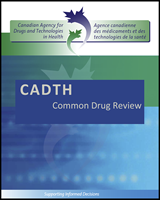Except where otherwise noted, this work is distributed under the terms of a Creative Commons Attribution-NonCommercial-NoDerivatives 4.0 International licence (CC BY-NC-ND), a copy of which is available at http://creativecommons.org/licenses/by-nc-nd/4.0/
NCBI Bookshelf. A service of the National Library of Medicine, National Institutes of Health.
Glycerol Phenylbutyrate (Ravicti) [Internet]. Ottawa (ON): Canadian Agency for Drugs and Technologies in Health; 2017 Apr.
Post-hoc evaluations of blood ammonia levels were performed in patients who were diagnosed with urea cycle disorders (UCDs) during infancy (early onset) and after infancy (late onset). For patients with UCD onset at two years of age or younger, the mean blood ammonia AUC0–24 levels were 17% lower with glycerol phenylbutyrate (GPB) treatment versus sodium phenylbutyrate (NaPBA) treatment. For patients with UCD onset after two years of age, the mean blood ammonia AUC0–24 levels were lower by 10% with GPB versus NaPBA.
Table 12Blood Ammonia Levels in Study HPN-100-006, Subgroup Analyses by Onset of UCD (Intention-to-Treat Population) — Post-Hoc Analysis
| Onset ≤ 2 years | Onset > 2 years | |||
|---|---|---|---|---|
| GPB (n = 10) | NaPBA (n = 10) | GPB (n = 34) | NaPBA (n = 34) | |
| AUC0–24 of Blood Ammonia Levels, μmol h/L | ||||
| Mean (SD) | 732.84 (604.13) | 878.91 (586.41) | 904.97 (679.73) | 1005.37 (937.14) |
| Between-group difference | −146.07 (205.85) | −100.40 (651.70) | ||
| P value for between-group comparison | 0.052 | 0.376 | ||
| Cmax of Blood Ammonia Levels, μmol/L | ||||
| Mean (SD) | 51.62 (36.92) | 60.23 (45.27) | 63.68 (48.76) | 73.94 (72.08) |
| Between-group difference | −8.61 (23.11) | −10.27 (47.68) | ||
| P value for between-group comparison | 0.269 | 0.218 | ||
AUC = area under the curve; GPB = glycerol phenylbutyrate; NaPBA = sodium phenylbutyrate; SD = standard deviation; UCD = urea cycle disorder.
Source: Clinical Study Report of HPN-100-006.24
A post-hoc analysis of glutamine levels was conducted in HPN-100-006. Mean ± standard deviation (SD) glutamine values were statistically significantly lower (P = 0.031, paired t-test; P = 0.017, Wilcoxon signed rank test) after GPB treatment compared with NaPBA treatment (757.7 ± 237.44 μmol/L versus 808.9 ± 251.48 μmol/L, respectively) in the safety population.
Table 13Mean Changes in Glutamine Levels in Study HPN-100-006 (μmol/L) — Post-Hoc Analysis
| GPB | NaPBA | |
|---|---|---|
| Safety population | N = 44 | N = 44 |
| Mean (SD) | 757.7 (237.44) | 808.9 (251.48) |
| Change from baseline to study end point | −57.1 (202.88) | 41.7 (163.11) |
| Difference between GPB and NaPBA, mean (SD) | −51.2 (152.23) | |
| P value | 0.031 | |
GPB = glycerol phenylbutyrate; NaPBA = sodium phenylbutyrate; SD = standard deviation.
Source: Clinical Study Report of HPN-100-006.24
- DETAILED OUTCOME DATA - Glycerol Phenylbutyrate (Ravicti)DETAILED OUTCOME DATA - Glycerol Phenylbutyrate (Ravicti)
- EXECUTIVE SUMMARY - Ustekinumab (Stelara)EXECUTIVE SUMMARY - Ustekinumab (Stelara)
- ADDITIONAL INFORMATION - Ustekinumab (Stelara)ADDITIONAL INFORMATION - Ustekinumab (Stelara)
- EXECUTIVE SUMMARY - Glycerol Phenylbutyrate (Ravicti)EXECUTIVE SUMMARY - Glycerol Phenylbutyrate (Ravicti)
- EXCLUDED STUDIES - Ustekinumab (Stelara)EXCLUDED STUDIES - Ustekinumab (Stelara)
Your browsing activity is empty.
Activity recording is turned off.
See more...
